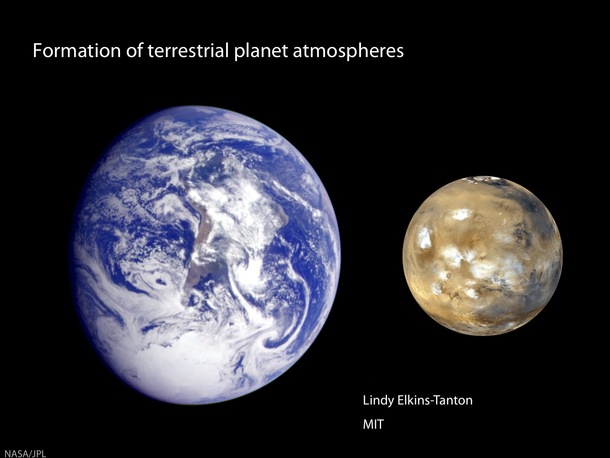Terrestrial Exoplanets > Linda Elkins-Tanton

If initial loading stalls, switch to the Flash version.
Formation of terrestrial planet atmospheres
Linda Elkins-Tanton
Massachusetts Institute of Technology, USA
Help



Abstract: Planets may obtain atmospheres from three primary sources: Capture of nebular gases, degassing during accretion, and degassing from subsequent tectonic activity. Compositions of primitive and differentiated meteorites provide a range of reasonable starting bulk materials for planetary formation and atmospheric degassing; virtually all meteorites carry at least traces of water, carbon, and sulfur, while some contain as much as 20% water. Material delivered early is likely to have been processed through a planetary melting event (a magma ocean), which are assumed to occur one or more times during the first tens of millions of years of planetary formation through accretionary impacts. A very small initial water content (less than a half mass percent) in the accreting Earth can produce a dense steam atmosphere, while a small change in chemistry can produce a carbon-based atmosphere, such as that on Venus. Recent work indicates that the earliest atmospheres degassed from rocky planets may in fact be highly reducing, producing methane or carbon monoxide atmospheres. Because the greatest majority of volatiles are liberated into the planetary atmosphere at the time of accretion, subsequent cooling is likely to lead to surface fluid oceans of water or carbon compounds, that will remain in chemical communication with the early atmosphere. Only a small fraction of the original volatiles remain in the solid planet, available to be released into the atmosphere through later volcanism. The low initial volatile contents required to degas a massive initial atmosphere that will collapse upon cooling into an ocean indicate that rocky super-Earth exoplanets may be expected to commonly produce water oceans within tens to hundreds of millions of years of their last major accretionary impact.
Additional materials: PDF of slides | Video of moon impact from the presentation
ExoClimes 2010, Exeter, Wednesday 8th Sep 2010
Additional materials: PDF of slides | Video of moon impact from the presentation
ExoClimes 2010, Exeter, Wednesday 8th Sep 2010
